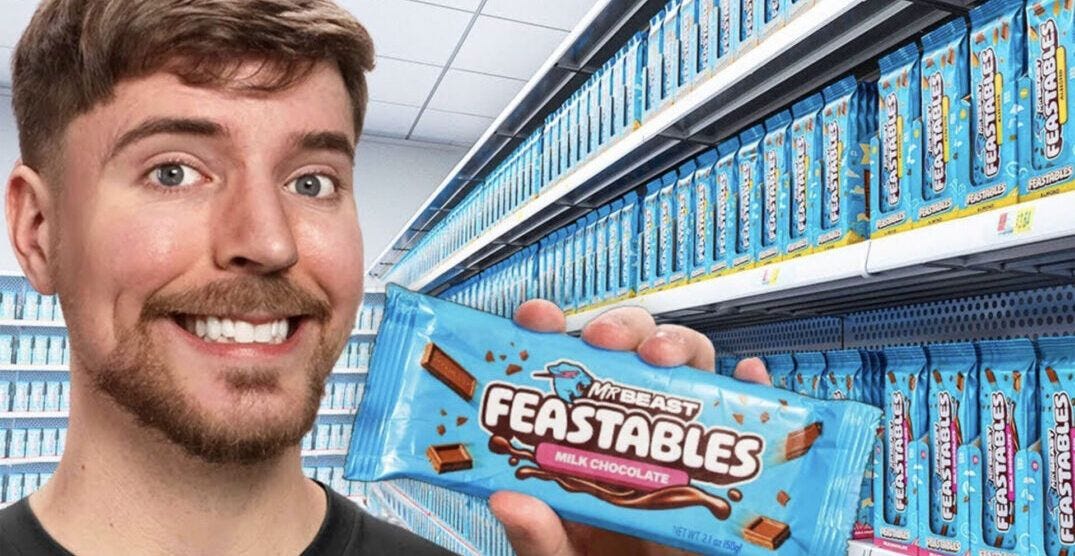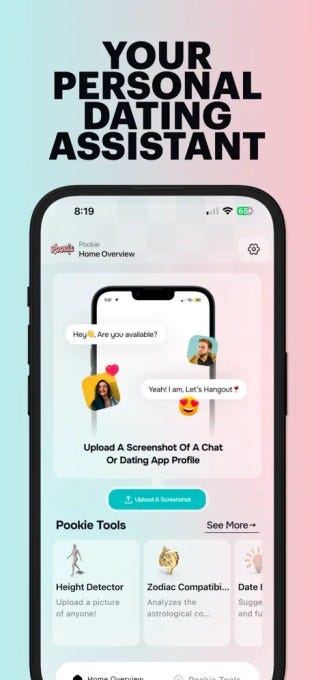In 2019/2020, venture capitalists started to get excited about the rise of the “creator economy," where creatives, influencers, and artists began transforming their online influence into businesses.
The premise was simple: Create content. Build an audience. Monetize.
Millions of creators on YouTube, Instagram, and TikTok leveraged their skills to build massive audiences, with many rising to internet fame almost overnight, thanks to algorithms.
They then marketed digital and physical products to their audiences—earning revenue directly, through affiliate links, and via sponsored posts.
The content race during Covid was intense.
YouTube channels, TikTok clips, Instagram posts, Substack newsletters, Spotify podcasts, Patreon subscriptions, and Cameo shoutouts. (We'll skip mentioning OnlyFans.)
The monetization options truly seemed limitless.
Jimmy Donaldson, better known as Mr. Beast, is the breakout star of the recent creator economy wave.
Growing up in Greenville, North Carolina, Jimmy dropped out of college to obsess over cracking YouTube's recommendation algorithm with his friends. No Stanford degree, no Y Combinator pedigree—just raw determination and creativity.
By 2022, MrBeast became YouTube's most-subscribed creator, amassing 112 million followers and leveraging his massive audience to launch venture-backed companies—all before turning 25.
While his ventures focused on consumer packaged goods (CPG) rather than software, they achieved staggering success. Take Feastables, his chocolate and snack brand co-developed with Night Ventures. Launched in 2022, it now generates $100 million in annual revenue.
I had the opportunity to consider an investment in Feastables before it launched but passed on the introduction, doubting the venture-scale potential of a chocolate brand.
Maybe I should’ve dreamed bigger.
Creators like Jake Paul have launched CPG brands—like his men’s personal care line, W—but most focused on monetizing their content and time, not building tech companies.
Meanwhile, VCs were pouring money into platforms designed to help creators grow and monetize their audiences—the so-called "creator stack."
If you were a VC in the early 2020s, your inbox was drowning in pitches with “creator economy” in the subject line (today, it’s all about AI). A glance at a 2022 creator economy market map is enough to make your head spin.
Every venture capital firm was trying to get a piece of the creator economy action — because it was supposed to be a very big economy for creators and platforms, which would result in public companies, M&A, and venture scale outcomes.
While creators grew their audiences and found ways to monetize, investments in the sector struggled to achieve venture-scale returns. Few companies scaled to sustainable billion-dollar valuations and there has been little liquidity via IPOs or M&A.
Platforms faced challenges with compressed margins as they fiercely competed to attract top talent. Building a venture-scale business becomes difficult when your share of digital subscriptions is limited to just 10%.
Most venture capitalists have quietly moved on from the creator economy. While they may not publicly acknowledge that the 2020-2022 creator economy boom was a bubble in the tech industry, get them talking over a glass of wine at a cocktail party, and they'll likely admit as much.
Enter: The Software Creator
So where does the creator economy go from here? Creators are still churning out TikTok videos. The numbers are staggering—there are over 207 million creators worldwide. 45 million of them identify as professionals.
Is it time to reconsider the concept as a viable venture capital opportunity?
In 2023, Slow Ventures unveiled a $20 million fund dedicated to individual creators, taking a unique approach. Instead of investing in "creator stack" platforms, they are directly investing in creators in exchange for a percentage of their future earnings.
Slow Ventures made a deal with Marina Mogilko, a language learning YouTuber and co-founder of the platform LinguaTrip. In exchange for $1.7 million in capital, she will give the venture firm 5% of her earnings for 30 years — plus, they keep that 5% stake in any IP she develops within those three decades. As she explained to VICE, “If I wrote a book in 2030, and it’s still selling in 100 years or whatever, they’re still getting 5% of that revenue.” (Techcrunch)
This approach gets to the heart of answering whether the creator economy is fit for venture capitalists. The answer is likely yes, but we are still in the experimentation stage.
At Chapter One, I’m genuinely optimistic about the creator economy today, driven by advancements in AI. Developing software and automating operational workflows is now easier than ever. Creators no longer need large engineering or operations teams to explore venture-scale ideas—just a modest amount of capital will do.
Large language models (LLMs) are becoming increasingly skilled at writing code, and we are witnessing a shift from creators selling products like chocolate bars (I should have invested!) to developing consumer-grade software applications.
The most impactful creators of the future won’t just produce content—they’ll create software as well. With AI-powered tools, creators can design, prototype, and scale software, expanding their influence far beyond selling digital subscriptions.
We’re quickly entering an era where internet-native users will have the ability to create consumer-grade software from the ground up.
Cursor and similar code generation tools will be used by many more people than today’s traditional developers.
While no-code tools initially held this promise—and platforms like Shopify partially delivered for e-commerce—most no-code solutions have fallen short of achieving a truly consumer-grade experience, often due to performance and UX/UI limitations.
That’s beginning to change.
Software Creators: Past and Present Examples
This week, Haliey Welsh (aka ‘Hawk Tuah’) launched Pookie Tools, an AI-powered dating advice app.
Haliey was just a normal person 3 months ago until she went viral for the Hawk Tuah video, but now she has 5 million followers on her social platforms. So why not build a dating assistant?
Welsh collaborated with a product studio to develop this product, and it seems likely that, in the future, she and a small in-house team could take over its development independently.
Is this the next venture-scale product? Unlikely. It’s more akin to "fast fashion for software" than a venture-scale business. Still, it’s a compelling example of how creators are increasingly exploring software development—and I’m confident it will drive revenue.
This trend isn’t entirely new. Back in 2014, Kim Kardashian introduced Kim Kardashian: Hollywood, a casual mobile game that allowed players to create and live the life of an aspiring virtual celebrity.
Within its first two years, the game generated over $157 million in sales. Glu Mobile, the game’s developer, never revealed its lifetime revenue, but the title generated hundreds of millions in in-app purchase (IAP) revenue before shutting down in April 2024 after an impressive 10-year run.
A notable example of a creator-turned-software entrepreneur is beloved parenting expert Dr. Becky.
During the COVID pandemic, Becky Kennedy, PhD, a clinical psychologist and mom of three, turned to Instagram to offer support and share tips for overwhelmed parents. Millions of followers flocked to her feed for her candid videos—such as those filmed on her closet floor—for her validating presence, warm yet sturdy demeanor, and pragmatic advice.
Good Inside, which began as Kennedy's social media movement and evolved into a New York Times best-selling book and a chart-topping podcast, has grown into a parenting-advice juggernaut that's attracting significant investor interest. In 2023, the company raised $10.5 million in its first venture capital funding round, led by Inspired Capital.
Good Inside is focused on using technology to expand upon the connection Dr. Becky has organically built with parents through various content channels and mediums. Their first product iteration included a subscription-based online community and content library ($279 annually), with a user experience centered around providing members with on-demand access to parenting solutions.
Supported by a talented team of technical operators, Dr. Becky and Good Inside have since taken it a step further, launching an innovative app with personalized, age-based parenting advice and an AI chatbot trained on Dr. Becky’s work and style. The AI chatbot is designed to feel like a direct conversation with Dr. Becky, leading to praise from Anthropic’s Mike Krieger. The company has been growing over 100% annually and reaches parents in more than 100 countries.
Another wildly successful recent example is Bryan Johnson, the anti-aging tech entrepreneur behind the "Don’t Die" movement. Bryan generated $20 million in sales within 24 hours of launching his Blueprint supplement products.
Blueprint was CPG supplements and not software, but Bryan created the Blueprint Protocol website, which went viral in 2023. He’s now developing the Don’t Die app, a subscription-based product aimed at helping users "slow their speed of aging together."
Bryan was the the founder and former CEO of Braintree—a payments company that acquired Venmo for $26 million and was sold to PayPal for $800 million in 2013.
He has taken the unconventional journey of moving from a successful founder to a prominent creator. Now, he’s back to building software, seamlessly blending the roles of creator and founder.
Content to Code: The Evolution Towards Software Creation
There are 2 million creators with over a million subscribers, but only a small fraction are currently able to develop software. That has changed.
We’re excited to meet content creators who are ready to build venture-scale software companies and services businesses that deeply connect with their audiences.
The ideal software creator is a content creator with millions of followers who feels burned out by the relentless content creation cycle and believes they can transform their creativity into something more enduring.
The companies they build might be social products, health and wellness platforms, online games, or dating apps — or entirely new concepts beyond our imagination.
At Chapter One, we are currently incubating a consumer application that leverages a large audience to give us a massive distribution advantage. This experience has been a real eye-opener to just how massive this opportunity could be—especially in a noisy world where winning on distribution is everything.
Our team has built products that have reached billions of users at companies like Twitter, Robinhood, Scale AI, and Tinder.
Now, we’re eager to work with future founders ready to evolve from Content Creators to Software Creators.
If you're a content creator with a cult-like following and want to become a software creator, reach out @jmj.










